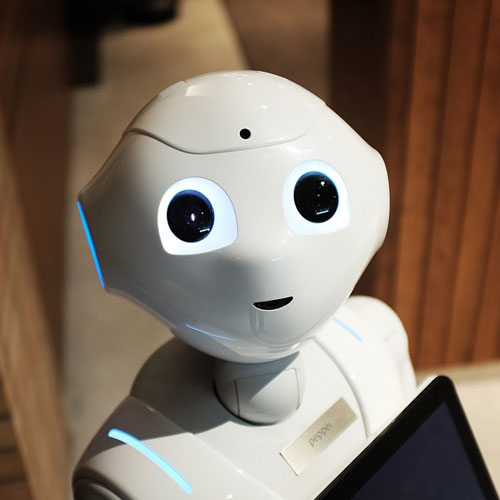
When Ray Kurzweil published “The Age Of Spiritual Machines” in 1999, he predicted a new era of thinking machines that will meet and then exceed human intelligence. The idea, which seemed outlandish at the time, doesn’t seem so crazy anymore. Today, computers are taking over the work of humans and it appears that we are entering a new industrial revolution. This session will look at biometrics, robotics, nano-bots, and transhumanism.
Before we get into robotics and more, let’s look at some technologies that rely on our biology and physical makeup. Biometrics is the name for any type of body measurements and calculations. But we are talking here about this process in technology. We have seen it in movies for decades, and just within the last 10-15 years have we begun to see it in our everyday lives – mostly in the form of identification and authentication on our mobile devices and work environments. And it will play a major role in the future. Biometric identification verifies you are you based on your body measurements. Biometric authentication goes one step further and uses that information to compare you against a database and enters your information in a service.
Think of it like this: biometric identification is like a neighbor who looks through the peeping hole at the 2 people who just rung the bell. The neighbor decides which one of them is Dave based on height, hair color, eye color and so on. Biometric authentication is the neighbor who looks through the peeping hole to see who is calling the door. If the neighbor validates that it is Dave, the door opens. If it’s not Dave, the door remains shut.
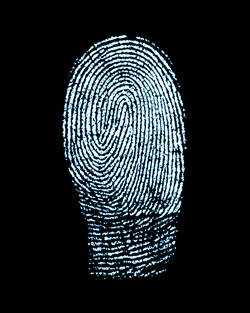 Fingerprint Identification
Fingerprint Identification
There are three types of fingerprint scanners: optical, capacitive and ultrasound.
An optical scanner takes a photo of the finger, identifies the print pattern, and then compiles it into an identification code.
A capacitive scanner works by measuring electrical signals sent from the finger to the scanner. Print ridges directly touch the scanner, sending electrical current, while the valleys between print ridges create air gaps. A capacitive scanner basically maps out these contact points and air gaps, resulting in an absolutely unique pattern. These are ones used in smartphones and laptops.
Ultrasonic scanners will make their appearance in the newest generation of smartphones. Basically, these will emit ultrasounds that will reflect back into the scanner. Similar to a capacitive one, it forms a map of the finger unique to the individual.
How are your fingerprints stored?
Both Google and Apple store your fingerprint on the device itself and do not make a copy of it on their own servers.
Apple’s TouchID won’t store the actual image of the fingerprint, but a mathematical representation of it. So even if a malicious hacker reaches this mathematical representation, he cannot reverse engineer it to reveal an actual image of your fingerprint. Not only that, but the fingerprint data itself is encrypted.
TouchID can be hacked but it’s still an extremely safe method of biometric authentication. For someone to hack an iPhone using TouchID sensors, they would need a really good copy of someone’s fingerprint. This will get them access to your unlocked phone, but not to a copy of your fingerprint, so it differs from stealing a password.
Also, not even the device’s OS can access the fingerprint data directly, much less an app. Instead, there’s a gatekeeper security software called Secure Enclave that sits between the fingerprint data and the program making the fingerprint scan request, such as ApplePay.
Android phones operate under similar guidelines. They store the fingerprint data in a secure part of the main processor called Trusted Execution Environment, or TEE for short. The TEE is isolated from other parts of the processor and doesn’t directly interact with installed apps.
Just as with Apple devices, fingerprint data is stored in an encrypted state. In addition, removing a user from the device should also delete any fingerprints stored on it.
While Apple has moved away from fingerprint scanning authentication and replaced TouchID with FaceID, other companies still rely on it.
How to secure smartphone/laptop fingerprint readers
Here are a few simple tips to help minimize the number of prints that are on your phone:
- Dress your phone with a fingerprint-resistant or oleophobic cover and screen protector.
- Use a different finger other than your index or thumb.
- If convenience is not your primary concern, use both the fingerprint and the password/PIN lock.
Eye scanners
Security researchers consider the eye as one of the most reliable body parts for biometric authentication since it the retina and iris remains almost completely unchanged during a person’s lifetime.
A retinal scan will illuminate the complex blood vessels in a person’s eye using infrared light, making them more visible than the surrounding tissue. Just like fingerprints, no two persons will ever have the same retinal pattern.
Iris scanners rely on high-quality photos or videos of one or both irises of a person. Irises too are unique to the individual. However, iris scanners have proven to be easy to trick simply by using a high-quality photograph of the subject’s eyes or face.
How iris scanners work:
When it comes to biometrics, the iris has several major advantages compared to a fingerprint:
- You don’t spread the information around every time you touch something.
- The iris stays virtually unchanged throughout a person’s life. A fingerprint, on the other hand, can be dirtied, scarred or eroded.
- You can’t use a fingerprint with dirty or sweaty hands. Irises, however, have no such problem.
- The only major disadvantage of an iris scanner is that high-quality photos of your face or eyes can trick the scanner and unlock the device.
Despite these limitations, the technology has made its way as a security feature in airports, banks, and other sensitive buildings. Of course, just like with other security measures, it’s used in conjunction with multiple authentication technologies.
Facial recognition systems
Generally speaking, facial recognition systems approach biometric authentication from a lot of angles.
The classic way is to simply extract your face’s features from an image (eyes, nose, distance between your lips and your nose etc) and compare them to other images to find a match.
Through skin texture analysis, your unique lines, beauty marks, wrinkles and so on are turned into a mathematical space, which is then compared to other images.
Both of them can be easily fooled with makeup, masks or, in some cases, simply obstructing part of your face. This is where thermal imagery and other technologies stepped up the game until we got to this point – that of widespread adoption of systems like the Apple FaceID.
The iPhone FaceID uses more than 30,000 infrared dots to map your face, then creates essentially a 3D map of your features. This map, like Touch ID, is sent to the Secure Enclave in the CPU to be compared with the one already stored on the device. The result? Your phone is unlocked just by looking at it.
In their marketing materials, Apple said there is a 1 in a million chance for someone else to unlock an iPhone using FaceID. Of course, that just sounded like a challenge for security experts. A researcher from Vietnam fooled FaceID with a 3D printed mask made from silicone and paper tape.
There are other biometric authentication methods – voice control (Amazon’s Alexa, Apple’s Siri, OK Google…), vein mapping, hand and finger geometry. All of these are ways to try to ensure access and security. And none of them are perfect. There are always hackers and people up to the challenge trying to out smart and trick these technologies. So if you feel you need the security, use multiple safeguards and back up as much of your data as often as you can.
What about artists and biometrics? Have a look at this Vice article featuring an artist’s work on protesting corporate data usage on our bodies.
This cool short video gives you some insight into the tech behind Apple’s FaceID.
This firm has actually hacked the FaceID technology!
Robot: For many people it is a machine that imitates a human or animal—like the androids in Star Wars, Alien or most other sci-fi adventures. These robots totally capture our imagination, but such machines still only inhabit movies and television. Scientists still haven’t been able to give a robot enough ‘common sense’ to reliably interact with a dynamic world. However, many labs all over the world are working hard at creating such humanoid robots.
 The type of robots that you will encounter most frequently today are robots that do work that is too dangerous, boring, onerous, or just plain nasty. Most of the robots in the world are of this type -they can be found in auto, medical, manufacturing and space industries. In fact, there are over a million of these type of robots working for us today. Do you think drones are robots? You bet – think of the service that Amazon is perfecting. A drone that will take a package and navigate the skies, follow directions to a residence, avoid trees and power line and know precisely where to land and deploy the box. But why not put that box on a UPS truck and let someone do it by hand? It’s (eventually) cheaper, faster and (hopefully) more efficient.
The type of robots that you will encounter most frequently today are robots that do work that is too dangerous, boring, onerous, or just plain nasty. Most of the robots in the world are of this type -they can be found in auto, medical, manufacturing and space industries. In fact, there are over a million of these type of robots working for us today. Do you think drones are robots? You bet – think of the service that Amazon is perfecting. A drone that will take a package and navigate the skies, follow directions to a residence, avoid trees and power line and know precisely where to land and deploy the box. But why not put that box on a UPS truck and let someone do it by hand? It’s (eventually) cheaper, faster and (hopefully) more efficient.
But what exactly is a robot?
As strange as it might seem, there really is no standard definition for a robot. However, there are some essential characteristics that a robot must have and this might help you to decide what is and what is not a robot. It will also help you to decide what features you will need to build into a machine before it can count as a robot.
A robot has these essential characteristics:
- Structure A typical robot needs a movable physical structure.
- Movement A robot needs to be able to move around its environment. Whether rolling on wheels, walking on legs or propelling by thrusters a robot needs to be able to move. To count as a robot either the whole robot moves, or just parts of the robot moves, like an arm or grip.
- Sensing First of all a robot would have to be able to sense its surroundings. It would do this in ways that are similar to how you sense your surroundings. Giving a robot sensors: light sensors (eyes), touch and pressure sensors (hands), chemical sensors (nose), hearing and sonar sensors (ears), will give the machine awareness of its environment.
- Energy A robot needs to be able to power itself. A robot might be solar powered, electrically powered, or battery powered.
- Intelligence A robot needs some kind of “smarts.” This is where A.I. enters the picture. As you recall from the session on artificial intelligence, we currently are limited to A.I. being restricted to just one specific task. This is a bg reason why robots have not been able to really manifest in ways that can focus on more than one thing. A hurdle that I am sure we will soon see effectively jumped.
Sound familiar? On the most basic level, human beings are made up of five major components: A body structure, a muscle system to move the body structure, sensory system that receives information about the body and the surrounding environment, a power source to activate the muscles and sensors, a brain system that processes sensory information and tells the muscles what to do. Of course, we also have some intangible attributes, such as intelligence and morality, but on the sheer physical level, the list above about covers it.
A robot is a machine that contains sensors, control systems, manipulators, power supplies and software all working together to perform a task. Designing, building, programming and testing a robot is a combination of physics, mechanical engineering, electrical engineering, structural engineering, mathematics and computing. In some cases biology, medicine, and chemistry might also be involved. Robotics scientists and engineers are actively engaged with all of these disciplines in a deeply problem-posing, problem-solving environment.
Interested in building a robot?
You should be! It’s quite a fascinating process, and everything you would need is very accessible and affordable (if you keep it simple). Like computers back in the day, a moderately skilled individual can put together a surprisingly advanced robot from scratch, using off-the-shelf parts and publicly available guides.
Here are a few tools and beginner robot projects:
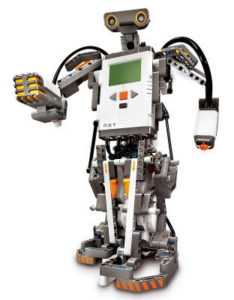 Lego Mindstorms
Lego Mindstorms
These archetypical building blocks claim millions of fans from all over the world—and with Mindstorms, enthusiasts can bring them to life. Mindstorm kits contain a variety of touch, pressure and light sensors, powered by a simple command box programming language. Notably, Mindstorms represent a genuine educational opportunity, as several versions of the kit are sold directly to schools making them a great starting place for a beginner robot enthusiast.
Arduino
Once you’ve mastered the capabilities of Mindstorms, the next step is to try something a little less user-friendly. Arduino is exactly the right choice. As a microcomputing platform with plenty of input/output slots, it offers a great open-source platform that sits at an intermediate difficulty level for hobbyists. Even better, it’s an extremely well-understood device—there are already a ton of detailed guides for making low-cost beginner robots.
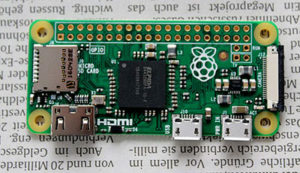 Rasberry Pi
Rasberry Pi
The Rasberry Pi is somewhat similar to the Arduino, but it has much more advanced capabilities. It’s a fully realized single-board computer, with an integrated graphics card and CPU clock speeds up to 1.2 GHz. Like the Arduino, there are plenty of tutorials for beginner robots involving this system already. As this system has more capabilities than Arduino, the resulting robots will be more full-featured, but its complexity may be intimidating to newer makers.
Scratch Programming Language
Both Scratch and Lego Mindstorms are the genesis of the MIT media lab. Like Mindstorms, Scratch is also designed to let beginners of all ages easily learn technical literacy skills. Not only is Scratch easy to program with, there’s a huge publicly available codebase with programs that people have already written, ready for you to re-use. And, Scratch is compatible with Rasberry Pi, Arduino, and Lego Mindstorms, allowing you to bring new programming functionality to any of your robotics projects.
One of the best things about robotics right now is that because there are so few major manufacturers (for consumer robots, anyway), that most are now created as open source. The means that even if you don’t think you have the technical skills to bolt and solder your own robot together, you can still take many commercial robots and program them to suit your whim.
The other great thing about robotics right now is that even if you feel intimidated by the task of programming or assembly, there are tens thousands of people out there in your shoes. Huge numbers of people are learning more about robotics every day, and as such there are a plethora of free resources available to interested learners. Check out some tutorials over at Make magazine, find interesting DIY projects at Instructables—for truly advanced learners, there’s even an Ivy-League robotics course available for free on YouTube. There’s an opportunity to learn for everyone at any age and any level of skill—so get out there and make some robots!
DID YOU KNOW?
The word Robot comes from the Czech word “robota” which means “ forced work or labor.”
Robots Ride to the Rescue Where Workers Can’t Be Found.
Fast-growing economies in Eastern Europe have led to severe labor shortages, so companies are calling in the machines.
NYTimes.com
Check out 7 of the most advanced robots active today.
Should we be looking at a Robot Tax as we move forward with this technology? Please watch this short piece by Full Measure with Sheryl Attkisson.
Watch Charlie Rose interview Sophia, a modern robot/A.I. created by David Hansen.
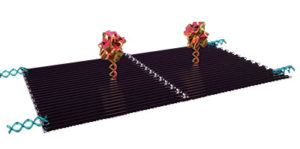 Nanorobotics is the technology of creating machines or robots at or close to the microscopic scale of a nanometer. Nanomachines are largely in the research and development phase, but some primitive molecular machines and nanomotors are currently being tested.
Nanorobotics is the technology of creating machines or robots at or close to the microscopic scale of a nanometer. Nanomachines are largely in the research and development phase, but some primitive molecular machines and nanomotors are currently being tested.
The first useful applications of nanomachines will be in nanomedicine. For example, nanorobots are already playing a role in targeting and killing cancer cells (in mice.) They will soon be active elements in biomedical instrumentation, surgery, monitoring of diabetes, and health care. Medical nanotechnology is expected to employ nanorobots injected into the patient to perform work at a cellular level.
Another potential application is the detection of toxic chemicals, and the measurement of their concentrations, in the environment.
There isn’t much material out there at this point, but this technology is going to grow exponentially. I guess it’s in our hands to make sure that it continues to be a resource for humanity that focuses on doing good, and not falling into the hands of mal-intended individuals or governments.
Please watch this short video on nanorobot technology in our current times.
Super-strong cell-size origami robots are coming! US physicists unveil game-changing biomorph nanobots. Andrew Masterson reports from COSMOS magazine.
Nanobots kill off cancerous tumours as fiction becomes reality!
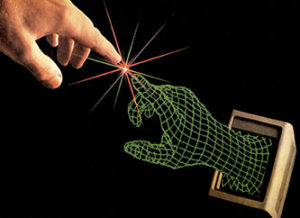 Remember the section when we looked into Ray Kurzweil’s ideas on technological singularity? Let’s have a quick look into the potential marriage of human, machine, advanced technology and artificial intelligence. Transhumanism is the drive to fundamentally revolutionize what it means to be human by way of technological advancements.
Remember the section when we looked into Ray Kurzweil’s ideas on technological singularity? Let’s have a quick look into the potential marriage of human, machine, advanced technology and artificial intelligence. Transhumanism is the drive to fundamentally revolutionize what it means to be human by way of technological advancements.
Transhumanists support the emergence and convergence of technologies including nanotechnology, biotechnology, information technology and cognitive science, as well as hypothetical future technologies like simulated reality, artificial intelligence, superintelligence, 3D bioprinting, mind uploading, chemical brain preservation and cryonics. They believe that humans can and should use these technologies to become more than human – in an effort to dramatically improve our lives with super longevity, super intelligence and super well-being.
Please watch this intriguing TED Talk with Jason Sosa on Transhumanism.
Transhumanism And The Future Of Humanity: 7 Ways The World Will Change By 2030
Forbes magazine has a great article on this idea of trans humanism.

No longer available


